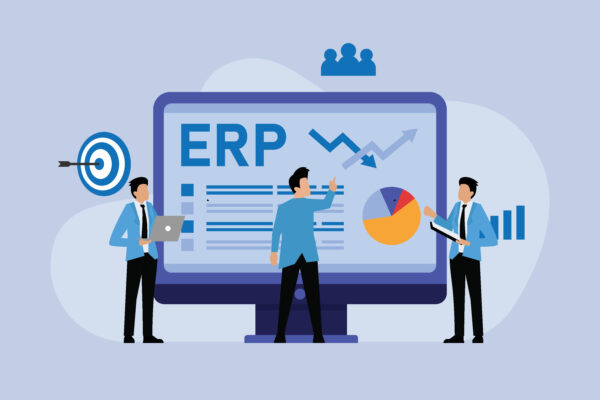Why ERP Stands Out: Unique Features Over Other Systems
This blog was originally published on June 16, 2023 and was updated on May 27, 2025.
Businesses today face overwhelming data volumes and operational complexities that demand efficient management solutions. Enterprise Resource Planning (ERP) systems integrate and streamline various business processes into a unified framework.
Understanding the distinctive features of ERP systems helps explain their growing prominence over traditional software solutions. Unlike standard applications that operate in silos, ERP offers comprehensive integration capabilities, real-time data processing and centralized data management, setting it apart as a powerful tool for organizations.
What is ERP?

ERP systems are comprehensive software solutions designed to streamline and optimize core business processes such as:
- Finance and accounting
- Human resources
- Operations
- Workforce management
By integrating these typically-siloed functionalities into a single cohesive platform, businesses gain enhanced visibility and control over their operations through an industry-specific ERP solution.
An ERP actively works to consolidate disparate data sources into one enterprise data warehouse, enabling real-time access, increased efficiency and informed decision-making. As technology evolves, so too do ERP systems, now often supported with advanced tools like business intelligence, analytics and AI capabilities.
Key Differences Between ERP and Traditional Software for Cleaning and Security Operations

ERP systems are fundamentally different from traditional software in their approach to integrating and managing business processes. Unlike traditional software, which often functions in silos serving specific tasks, ERP systems are designed to centralize and unify these processes under a single interface.
| ERP Systems | Traditional Software |
| Centralized, unified processes | Siloed, disconnected functions |
| Streamlined data management | Fragmented information systems |
| Organization-wide visibility | Limited departmental scope |
| Fast information access | Delayed data updates |
Modern ERP solutions provide flexibility and scalability through cloud-based deployments. Traditional software often relies on on-premises systems, restricting adaptability and growth potential. Additionally, cloud-based ERP solutions offer organization-wide visibility, enabling businesses to identify inefficient manual processes and uncover opportunities for growth.
Integration Capabilities
One of the hallmark features of ERP systems is their integration capabilities. These systems facilitate seamless communication and data flow between integrated modules, ensuring accurate and real-time information sharing across various departments.
Key integration benefits include:
- Holistic view of organizational operations
- Enhanced decision-making and collaboration
- Elimination of duplicate data entry
- Reduced errors and inconsistencies
- Improved cross-functional coordination
ERP systems utilize data mapping, standardized data formats and application programming interfaces (APIs) to effectively connect different functionalities. This integration capability allows businesses to streamline back-office processes from accounting and finance to human resources and customer relationship management.
Real-time Data Processing
Real-time data processing is a pivotal feature of ERP systems. This capability allows project managers and project management departments to make decisions based on reliable data, dynamically impacting essential metrics such as budget burn and profit margins.
By providing real-time data on inventory levels and production schedules, ERP systems enhance communication and coordination across the supply chain. With centralized access to real-time data, organizations can uncover impactful trends and gain extensive actionable business insights, driving better decision-making.
Real-time processing advantages:
- Immediate visibility into operational status
- Faster response to changing conditions
- Enhanced collaborative decision-making
- Reduced latency in information flow
- Improved service delivery and customer satisfaction
Centralized Data Management
ERP systems excel in centralized data management, bringing order to the chaos of information spread across an organization. By creating a unified database for various business functions, ERP solutions provide a single source of truth.
This centralization ensures:
- All users access correct, up-to-date information
- Data accuracy is significantly improved
- Redundant data entry is eliminated
- Information consistency is maintained
- Decision-making is based on complete data
The central collection of data in ERP systems facilitates efficient information distribution, reducing dependency on error-prone spreadsheets. By minimizing data duplication and allowing real-time data access across different departments, ERP systems significantly enhance visibility into business performance.
Understanding the benefits of centralized data is crucial for organizations looking to improve their information management and overcome the challenges of fragmented systems.
Unique ERP Features for Commercial Cleaning and Security Businesses

One of the standout aspects of ERP systems is their ability to offer advanced features that enhance business operations across multiple dimensions.
Advanced ERP Capabilities:
- Powerful forecasting tools for proactive planning
- Comprehensive analytics for business intelligence
- Customizable reporting for management insight
- Automated workflows for process efficiency
- Integration capabilities with specialized systems
By utilizing these tools, businesses can make informed decisions, forecast future requirements and optimize their processes to align with strategic goals. The automation of everyday business functions significantly reduces manual data entry and errors, allowing employees to redirect their efforts toward more critical and higher-value tasks.
ERP systems also excel by seamlessly integrating with existing software providers, facilitating smooth data exchange across all operations. This ensures consistency and accuracy of information, which is crucial for maintaining operational efficiency and responding swiftly to market demands.
Advanced Analytics and Reporting
ERP systems provide robust analytics and reporting capabilities, which deliver crucial data-driven insights into various aspects of operations. This capability is essential for identifying trends and optimizing processes across the organization.
Enhanced analytics and business intelligence (BI) features in ERP systems deepen insights into business performance, significantly improving decision-making. These features include:
- Interactive dashboards with key performance indicators
- Customizable reports for different management levels
- Analytics to forecast future trends
- Data visualization tools for intuitive understanding
- Role-based information delivery for relevant insights
By integrating operational data, ERP systems effectively eliminate data silos, allowing for a comprehensive view of business operations.
Benefits of Using ERP Systems

Enterprise Resource Planning software (ERP) systems have become indispensable tools for modern businesses seeking to enhance their operational efficiency and remain competitive.
This centralization enables businesses to:
- Streamline core business processes
- Improve decision-making with comprehensive data
- Enhance transparency across departments
- Reduce operational inefficiencies
- Support growth and scalability
Increased operational efficiency
ERP systems are renowned for their ability to significantly enhance operational efficiency. By streamlining processes and reducing manual tasks, these systems eliminate redundancies, resulting in notable improvements across operations.
Integration of various departments leads to consistent and accurate data, which enhances decision-making and operational effectiveness. With improved visibility of data across functions, businesses can respond more swiftly to orders and manage workflows with greater precision.
Efficiency improvements include:
- Automated workflow processes reduce manual intervention
- Standardized business procedures ensure consistency
- Optimized resource allocation improves utilization
- Streamlined supply chain processes reduce bottlenecks
- Enhanced inventory management prevents stockouts or excess
Improved decision-making with real-time insights
ERP systems significantly enhance decision-making by centralizing critical business processes, thus making real-time data more accessible across the organization.
The robust reporting and analytics tools provided by ERP solutions offer businesses the ability to:
- Track key performance indicators (KPIs)
- Gauge the impacts of changes across departments
- Identify trends and patterns in operational data
- Forecast future performance based on historical data
- Make data-driven decisions with confidence
Access to real-time data across company functions uncovers impactful trends, facilitating informed decisions by organizational leaders.
The increased accuracy in data management and reporting reduces the likelihood of errors, ensuring that decision-makers rely on consistent and reliable information. ERP systems support regulatory compliance by maintaining an audit trail and adhering to approval workflows.
For security operations, these decision-making capabilities are particularly valuable. Security incident management requires swift, data-driven responses and ERP systems provide the real-time information needed to effectively handle security events and analyze patterns to prevent future incidents.
Greater transparency across departments
One of the standout features of ERP systems is their ability to provide greater transparency across departments. By centralizing data into a single source of truth, ERP platforms offer a unified vision of information throughout an organization.
Transparency benefits:
- Elimination of data duplication and inconsistencies
- Enhanced data integrity and reliability
- Seamless communication between business units
- Improved collaboration across departments
- Greater visibility into cross-functional processes
With real-time data access, ERP systems enhance decision-making capabilities and operational efficiency across all business functions. They provide transparency into business processes by tracking production, logistics and financial metrics, fostering better collaboration among teams.
This integration of multiple business functions within an ERP system allows stakeholders to monitor performance effectively and make informed decisions based on comprehensive data insights, aligning strategies to business requirements and objectives.
Common Challenges with Traditional Systems

Traditional systems present several hurdles that can impede a business’s operational efficiency and growth. Among these challenges are issues related to data integration, costs and adaptability.
Key limitations of traditional systems:
- Data fragmentation across multiple platforms
- Integration complexity between disparate systems
- High maintenance costs for multiple solutions
- Limited scalability to accommodate growth
- Inconsistent reporting due to data discrepancies
Data quality and format standardization issues often emerge during migrations to an ERP system, complicating the integration process. This is compounded by the significant initial financial burden required for software licenses and the necessary infrastructure. For many organizations, maintaining and updating these traditional on-premises ERP systems is daunting, as this responsibility rests solely on their shoulders.
Security and cleaning companies face unique operational challenges that traditional systems often cannot address effectively. Understanding these industry-specific challenges is essential when evaluating technology solutions for these specialized service providers.
Data silos and fragmentation
Hybrid systems can create data silos if not properly integrated, leading to isolated information across different parts of the system. This isolation hinders overall operational efficiency.
Impacts of data silos:
- Duplicate and inconsistent information
- Limited cross-departmental visibility
- Inefficient decision-making processes
- Reduced operational agility
- Compromised data integrity
An ERP system can significantly mitigate these issues by centralizing data, ensuring that all users access consistent information derived from common processes. Without proper integration, businesses might resort to standalone databases and disconnected spreadsheets, further fragmenting their data.
An effectively deployed ERP system enables uniform data element identification across departments, reducing the risk of silos and fostering a cohesive data strategy.
Inefficiencies in workflow
Businesses lacking ERP software often encounter workflow inefficiencies, including duplicate data entry and manual errors that can adversely affect profit margins.
Common workflow challenges include:
- Multiple data entry points creating redundancy
- Manual processing leading to errors and delays
- Inconsistent processes across departments
- Limited visibility into process bottlenecks
- Difficulty tracking process performance
The usage of multiple systems for routine tasks results in high error rates due to excessive manual data entry, contributing to operational inefficiencies. Inconsistent databases across various systems exacerbate this, hindering effective decision-making due to poorly integrated data.
Additionally, having sensitive data accessible by multiple staff members without adequate control increases security vulnerabilities. These issues point to the necessity of a new or upgraded ERP solution that can streamline workflows and enhance data integrity.
Limited insight into performance metrics
ERP systems enrich reporting capabilities, allowing businesses to produce accurate and comprehensive reports that enhance understanding of performance metrics and enable effective planning.
Enhanced metric visibility with ERP:
- Real-time access to performance indicators
- Consistent measurement methodologies
- Cross-functional performance correlation
- Historical trend analysis
- Predictive performance forecasting
Leading solutions are equipped with advanced reporting and analytics tools that track key performance indicators (KPIs) and various metrics, fostering a clearer understanding of organizational performance.
By providing centralized data access, ERPs reveal impactful trends and extensive business insights, which empower leaders to make informed decisions. ERP systems integrate real-time data, allowing businesses to monitor and evaluate performance metrics accurately, thus facilitating strategic decision-making across departments.
This comprehensive insight into interdepartmental changes and their effects on overall performance is invaluable for sustaining competitive advantage.
How ERP Adapts to Future Business Needs

Modern Enterprise Resource Planning (ERP) systems utilize cutting-edge technology including AI, machine learning and the Internet of Things (IoT). These technologies help businesses optimize operations and maintain a competitive edge.
Forward-looking ERP features:
- AI-driven analytics
- Machine learning for process optimization
- Mobile accessibility for remote workforce
- Flexible architecture for future expansion
Benefits of TEAM Software ERP Solutions
Partnering with TEAM Software by WorkWave can significantly benefit your commercial cleaning or security business. Our comprehensive workforce management solutions are designed to streamline operations, improve efficiency and ultimately help you grow your client list.
Key benefits of TEAM Software include:
1. Efficient Employee Management
- Schedule shifts across multiple locations
- Assign tasks with precision and tracking
- Monitor employee performance metrics
- Optimize workforce deployment for better service
2. Improved Communication
- Connect managers with field personnel
- Respond quickly to client requests or changes
- Update scheduling as needs change
- Coordinate team activities for better outcomes
3. Improved Invoicing and Billing
- Streamline the complete billing cycle
- Track payments and client accounts efficiently
- Ensure timely and accurate client billing
- Reduce administrative overhead in financial processes
4. Comprehensive Reporting and Analytics
- Generate detailed performance reports
- Gain valuable insights into business operations
- Make data-driven decisions with confidence
- Optimize operations with in-depth analytics functions
Closing Thoughts
Businesses today need streamlined operations and real-time data access to succeed. By consolidating your tasks through an ERP solution like TEAM Software by WorkWave, you can enhance operational efficiency, improve inventory management and boost customer satisfaction.
Implementing TEAM Software provides you with comprehensive tools for:
- Job costing and financial management
- Workforce scheduling and coordination
- Client relationship management
- Business intelligence and analytics
Experience the benefits of having a unified ERP solution tailored to meet the unique needs of your industry. Request a demo today to see how TEAM Software can improve your business operations.
